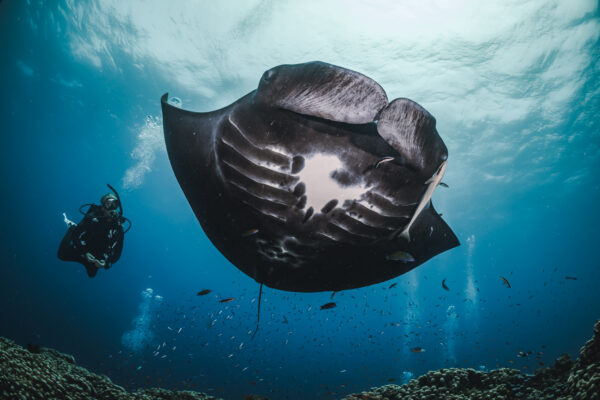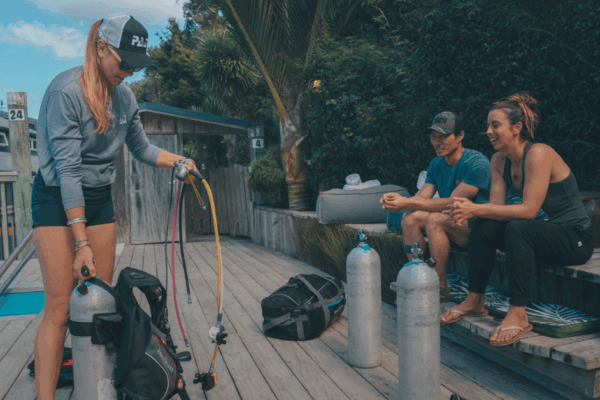“The only constant in life is change.” – Heraclitus
The only constant in life is change. Heraclitus of Ephesus said this about 2,000 years ago, and in some form or the other, this still applies and shows up everywhere — from blogs to t-shirts, Etsy to Pinterest. But it’s a phrase that’s held good over the centuries.
There are times when theoretical catchphrases transcend the Instructor Manual and enter daily practice. This article examines how competitive freediving benefits instructors and, in turn, positively impacts their students.
Competing vs Teaching: Two Roles, One Ocean
Competition/athletic roles and teaching/instructional roles are generally viewed as two separate dimensions. I recently competed in my first freediving pool competition in Malaysia with my instructors from Kaizen Freediving — three nationalities with varying levels of experience ranging from two years to 12+ years, all PADI Freediver Instructor Trainers. Sounds odd, right? There seems to be an unusual Venn diagram here.
The numbers were respectable — seven white cards across disciplines between the trio — but the true value was the conclusion of a training cycle that involved teaching courses over three months, culminating in this one event.
It was a greatly rewarding experience. I share these experiences now, broken down into two simple parts:
- Why and what’s in it for the instructor
- How it benefits the students
Why Compete at All?
Because… why not?
A simplistic reply, but there are deeper reasons why the very act of participating in competitions is beneficial. Every course has a set of performance requirements — benchmarks that define progress at each level of freediving. Here’s a quick overview:
| PADI Course Level | Static Apnea (STA) (Min:Sec) | Dynamic Apnea (DYN) | Constant Weight (CWT) (Min) |
| Freediver | 1:30 | 25 meters | 10 meters |
| Advanced Freediver | 2:30 | 50 meters | 20 meters |
| Master Freediver | 3:30 | 70 meters | 32 meters |
The Self-Imposed Performance Requirement
But what happens after becoming an Instructor/Instructor Trainer? Officially, there are no more courses to do. But learning does — and should — not stop just because there are no more certifications.
What comes after that? Going beyond these numbers is a story of growth and a desire to explore. The exact number is not important. The journey is.
The drive to learn more and share more. There is no gatekeeping involved here. As freedivers, these are shared experiences that only a small percentage of Earth’s population can relate to.
The 100-meter (328-foot) mark is often described as freediving’s Everest — but unlike the mountain, far fewer people have reached that depth. It’s a milestone that remains one of the most elusive achievements in human performance.
Both Everest and freediving come with their own unique challenges, but the summit is not the only quest for us. It’s to reach the bottom… and come back up to share the joys of that dive journey.
A competition is a self-imposed performance requirement.
Being overly focused on achieving numbers is something my trifecta of aquatic instructors — Shonali Ghosal, Svetlana, and Sergei — have advocated against. But a goal is good.
Achieving the goal leads to activating a dopamine pathway. It’s something we’ve all experienced. “The first time I did 10 meters (33 feet)” or “My first time freediving…” is a story all freedivers have. So… why not have more of those?
That story is partly built on the foundation of achieving performance requirements. That journey is rewarding, brings back memories and activates pathways in the brain that push us further to explore the world of apnea — all at our own pace.
Personal Growth
Having become an instructor, there is a desire to be better, and learning new skills is part of that process. The better we become, the better our understanding of a sport that is deeply inward-looking. To quote the legend himself, Umberto Pelizzari, “The scuba diver dives to look around; the freediver dives to look inside.”
By experimenting and trying to reach newer depths, we unlock a process that can only be learned by doing it. No amount of research can replace that kind of learning. A deeper understanding of the self that can then translate into a more nuanced explanation for the students we teach.
It doesn’t have to be a world record or a national record to count. It’s the journey of waking up every morning, then trying out new training plans and workout protocols to benefit performance.
Peer Learning
I’m extremely fortunate to train along with two other Freediver Instructor Trainers. These training sessions have resulted in:
- Better technique
- Higher performances
- Better results
But mostly, it has translated into a far better and more refined teaching experience after the competition. Competitions are also a smorgasbord of personalities from all walks of life.
Each one brings forth their own experiences into the pool. A rock climber or a ballet dancer view comfortable footwear uniquely. They will most likely shrug off tight-fitting monofins as just a part of the sport; rock climbing shoes are an example of when footwear is designed with no comfort in mind. For them, performance matters; the discomfort is secondary.
These kinds of insights are gleaned over conversations while stretching and breathing up during the competition, leaving a lasting impression of the experience.
Gains for the Instructor
Competitions are an instructor’s continuing education.
We continue to be humble students of the ocean and our own bodies. The drive to learn, practice and share only intensifies with each training cycle.
And that word is important; it’s a cycle. It’s not vicious. It’s not focused on an extraneous reward system. It’s internal. It’s continuous.
That means that winning and setting records are not the only way to gain. They don’t matter as much. And that’s what we’d like to teach: numbers are just that — numbers.
If you put in the time and hard work, it will happen. The part we’ll truly remember is the journey.
Gains for the Students
When instructors grow, students feel it. A teacher who’s just returned from a training cycle or competition doesn’t just bring back numbers; they bring back nuance, whether that’s a slightly better fin stroke, a more intuitive way to explain equalization or just the calm confidence of someone who has tested themselves and come out wiser. That shows.
And students pick up on it. They start to understand that the journey isn’t just about reaching 20 meters (66 feet); it’s about how you show up in the water.
When they see their instructor still learning, still chasing that internal why, it’s contagious. Growth becomes a shared space, not just a curriculum box to tick off.
In the end, competing isn’t just for medals. It’s a mirror, and every dive teaches us something new about how we learn, grow and teach
About The Author: Akshay Thatte is a PADI Instructor Trainer and National Record Holder in Dynamic Apnea for India. The Indian Army Veteran is now teaching full-time at Kaizen Freediving, Koh Tao, Thailand, and spends his free time with the dogs, cats and fauna of Koh Tao. Follow his thoughts on his Substack or @akshay_aquanaut on Instagram.



